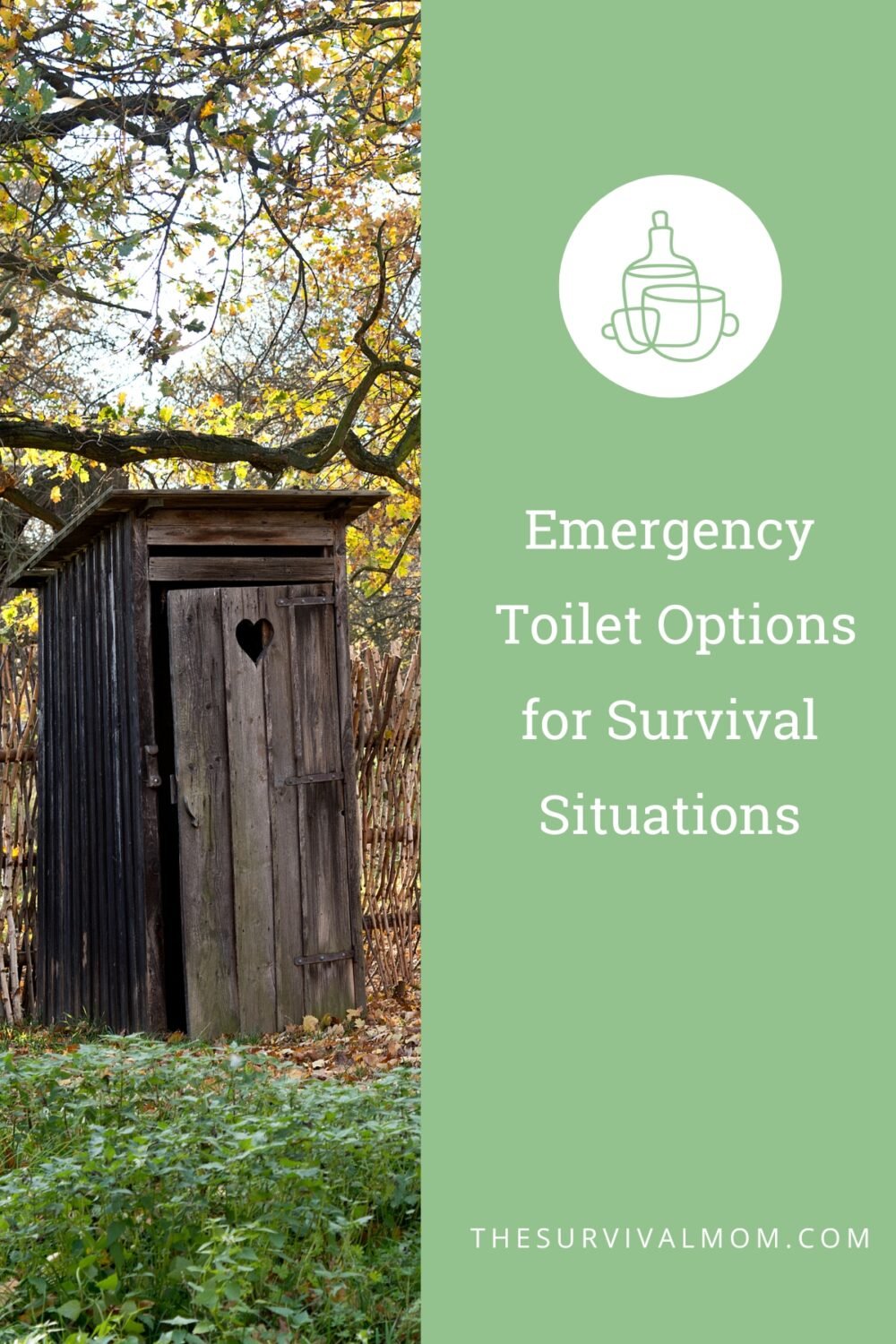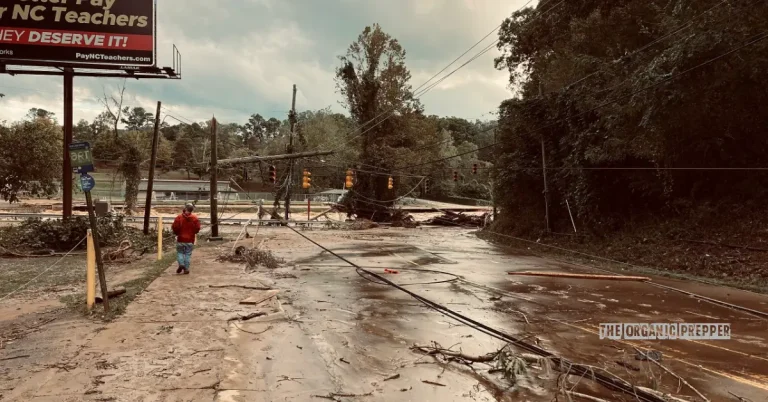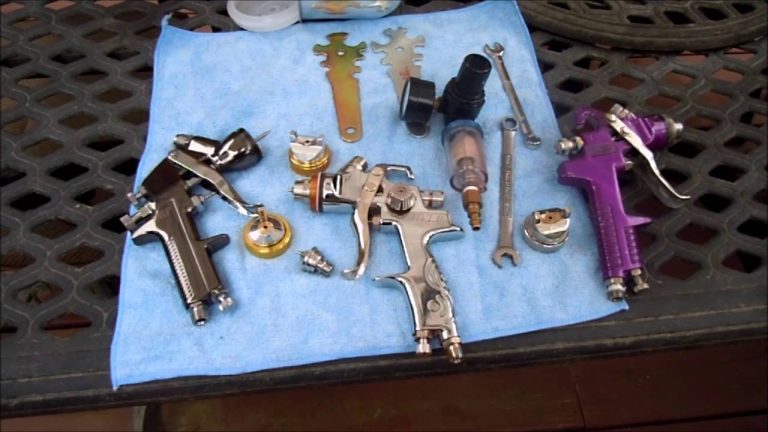Some of the links in this post may contain affiliate links for your convenience. As an Amazon associate I earn from qualifying purchases.
Pooping…there’s nothing we like better as a society than sharing our defecation experiences. Ok, you got me. While we all have to do the “Number 2” to survive, it remains a very private experience. Couples that don’t think twice about urinating in front of each other draw the line.
Under normal circumstances, the details of pooping and peeing are pretty straightforward. Wipe, flush, and you’re done. Yet in a significant disaster, our options for sanitation are limited and ignorance of proper disposal of waste can lead to discomfort, discord, and health hazards. Survival sanitation, then, becomes one of our highest priorities. You simply must have a plan for an emergency toilet and waste disposal.
Sanitation and Disease
Contact with human waste can carry so many diseases that it’s only smart to be concerned. Some of those diseases are cholera, dysentery, giardia, typhoid fever, and hepatitis. Clearly we don’t want to return to the days of these diseases running rampant.
So, what’s a person to do in a worst case scenario?
Having this discussion in advance with the whole family is an important step in normalizing this uncomfortable adjustment to our hygiene habits. I’ll talk about how to do this later in this article.
According to the Oregon State University (OSU) Extension Service, one of the reasons some families and communities have “toilet blindness” is because prior disasters like snowstorms, fires or epidemics don’t damage sanitation systems and infrastructure.
What Can Happen to Sanitation Systems after Disasters
Let’s examine the problem. Potable water and working sewers are necessary for modern sewage systems to operate. In many areas, electrical power drives the pumps for potable water and sewage systems. Private well pumps also rely on electricity. So any disaster that affects the power grid also impacts your sanitation strategy. Still, if you have the water available and an intact sewer or septic tank, pouring water into the toilet will allow normal flushing.
Then there are more complicated disasters, such as floods. These types of events can directly affect potable water and sewage systems by causing backflows and interfering with gravity-flow systems. In this case, sewer lines can become a direct threat to you unless you have a valve or plug to prevent backflow into your house.
Similar issues can develop with your septic system. Earthquakes can create a whole new level of havoc, breaking both potable and sewage water lines and causing cross-contamination.
Depending upon what hazards are common to your area, you should plan for the worst case.
An Emergency Toilet in Action
I have a story to illustrate how even highly trained emergency responders have trouble with this issue. Jim Acosta was the Team Leader of a 150-member federal Disaster Medical Assistance Team. This team was trained and equipped to set up a medical clinic with physicians, nurses, and paramedics in the midst of the worst disaster areas. They had a field exercise where they set up field toilets. These emergency toilets consisted of a 5-gallon bucket with a plastic seat and a “Wag-Bag,” a plastic liner with a gelling agent inside to capture waste and allow disposal in regular garbage.
All personnel were trained in how to use it. Yet at the end of the first day it was clear that some refused to follow the directions. Some Wag-Bags were left on the ground and some of the buckets were filled with waste; it was a mess. As a result, they assigned a monitor to inspect each toilet after use so their health could be maintained.
Options for Survival Sanitation
There are several options for emergency toilets and waste disposal if the traditional toilet is not available.
The Camping (Chemical) Toilet
The closest thing to the normal toilet experience is the camping (chemical) toilet. These units have a several-gallon waste tank, a small water tank, and some kind of pump for flushing. The operation is similar to a regular toilet, and a chemical is used to deodorize the waste. For short-term use, this is a good solution; however, in situations where water is at a premium, the water used for flushing is better used for drinking or washing.
A 5-Gallon Bucket
Here is an excerpt from my book that helps answer this question for a very basic emergency sanitation solution.
When the toilet won’t flush, or when flushing toilets aren’t within driving distance, having a good, sturdy shovel on hand would be a good idea. However, there are a couple of options a little higher up on the evolutionary scale.
The 5-gallon bucket wasn’t invented just for janitorial use. In fact, it can make a mighty fine, albeit temporary, substitute for your toilet.
Here’s what you’ll need:
- A 5-gallon bucket. You can be choosy about the color, but really, in the end, it doesn’t matter.
- A snap-on toilet seat makes the experience more comfortable and homey. An old toilet seat works just as well, as long as it doesn’t slip off while holding its passenger.
- Heavy-duty trash bags. Plan on using two of these to line the bucket. Commercial liners specifically designed for this purpose are another option.
- A supply of kitty litter, sawdust, peat, or dirt.
- Unscented liquid bleach, diluted with water in a 1:10 solution.
- Air freshener.
Line the bucket with two of the trash bags and snap on the toilet lid. Sprinkle a cup or 2 of kitty litter in the bottom of the bag and after each “Number 2.” Additionally, sprinkle a cup or 2 of the bleach solution into the bag to kill bacteria.
Your Bathroom Toilet
Another option I mention in the book is to continue using your bathroom toilet. Empty out all the water and then follow the above steps beginning with, “Heavy-duty trash bags…” If you keep the toilet seat and bathroom door closed, the odor won’t be overwhelming.
The 2-Bucket System
The two-bucket emergency toilet improves on the single bucket system because it stops bad smells, lowers the chance of germs spreading, keeps things cleaner, makes it simpler to throw away waste, and lasts longer. It does this because the use of dual buckets means poop and pee are kept separate. The OSU Extension Service has a great pamphlet detailing this two-bucket, no-mix toilet system.
The Slit Latrine
The most basic sanitation method is the slit latrine, a narrow but deep and long hole in the ground over which you squat and do your thing. The idea is to start at one end and as each person poops, they stir their contribution into the dirt with a stick and cover it. Some provision of privacy is provided with hanging sheets or other barriers.
As long as this trench is located away from ground water sources, this is fairly hygienic. That makes this solution less viable in an urban off-grid environment, at least as a long-term solution.
For an in-depth view of outdoor elimination, check out Kathleen Meyer’s How to Shit in the Woods.
What to Do With The Human Waste
The problem with both these solutions is that the bagged waste will have to be disposed of each day. If you live in a city, this could become a real problem because guess what? Everyone else around you is dealing with the same issue. City parks, green belts, and the like will soon become makeshift landfills.
While there are no great options, here are a couple that can help manage excrement.
Bury it
Identify a location at least 200 feet from any source of drinking water and bury the waste. Ensure the bag is tightly sealed, then dig a hole a minimum 10 inches deep to prevent determined rodents and pets from reaching it. I know dogs that will eat poop. You don’t want that!
Store it
Keep a lidded container, like a 32-gallon garbage can, at a location distant from where you are living or sheltering. Store the bags of waste in the container. Have some way to secure the lid so that inquisitive creatures can’t gain access. When sanitation services resume, watch for details on way to do with the container’s contents.
Discuss Survival Sanitation with Your Household
Just having the equipment available doesn’t solve the problem. You need to have the Talk. The Talk should include:
- Acknowledging that the situation is uncomfortable
- Noting that everybody has to do their business
- This is the best compromise for everyone, whatever option works best for you.
- The situation is only for a limited time.
- Everyone’s privacy will be respected.
Better to have the conversation now so everyone can begin developing the right attitude about emergency toileting. After a disaster, stress levels will have skyrocketed.
Don’t over-worry about this!
Too often we imagine scenarios right out of Hollywood: Mad Max and The Road come to mind. But keep in mind that these films are pretty far out there in terms of being realistic. Their intent is to shock and make money, not necessarily in that order.
Yes, an EMP could take out the entire grid in North America, but then again, it might not. It might affect some areas more than others, some electronics more than others. There are too many unanswered questions about the potential and likely effects of EMP, and really, it shouldn’t be at the top of your list when it comes to being prepared. Not even in the Top 5.
Plan for what is most realistic: a fairly short-term emergency. The last thing government officials want, regardless if it’s city, county, state, or otherwise, is an out-of-control emergency that endangers the lives of millions. Think about it. If 75% of the population dies, who will be left to pay taxes?? If at all possible, sanitation services, at the very least, will be up and running as quickly as possible.
Final Thoughts
Our discomfort with the subject of sanitation doesn’t relieve us from planning for our needs in an emergency. Addressing the subject in advance, with a healthy dose of humor, with make this aspect of weathering a disaster a little less uncomfortable.
What kind of emergency toilet supplies do you store?
Originally published June 22, 2014. Includes contributions from Jim Acosta.

















